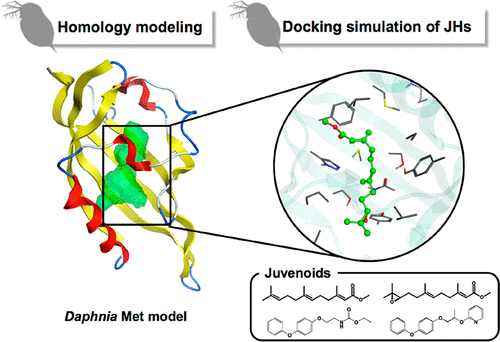当前位置:
X-MOL 学术
›
Chem. Res. Toxicol.
›
论文详情
Our official English website, www.x-mol.net, welcomes your
feedback! (Note: you will need to create a separate account there.)
Molecular Insights into Structural and Ligand Binding Features of Methoprene-Tolerant in Daphnids
Chemical Research in Toxicology ( IF 3.7 ) Pub Date : 2020-10-22 , DOI: 10.1021/acs.chemrestox.0c00179 Masashi Hirano 1 , Kenji Toyota 2 , Hiroshi Ishibashi 3 , Nobuaki Tominaga 4 , Tomomi Sato 5 , Norihisa Tatarazako 3 , Taisen Iguchi 5
Chemical Research in Toxicology ( IF 3.7 ) Pub Date : 2020-10-22 , DOI: 10.1021/acs.chemrestox.0c00179 Masashi Hirano 1 , Kenji Toyota 2 , Hiroshi Ishibashi 3 , Nobuaki Tominaga 4 , Tomomi Sato 5 , Norihisa Tatarazako 3 , Taisen Iguchi 5
Affiliation

|
Juvenile hormone (JH) is an important endocrine factor regulating many biological activities in arthropods. In daphnids, methoprene-tolerant (Met) belongs to a basic helix–loop–helix/Per-Arnt-Sim (bHLH/PAS) family protein which has recently been confirmed as a JH receptor and can bind and be activated by JHs and JH agonists. Although the activation of the JH signaling pathway causes many physiological effects, the molecular basis for the structural feature and ligand binding properties of Daphnia Met are not fully understood. To study the ligand preference in terms of structural features of Daphnia Met, we built in silico homology models of the PAS-B domain of Daphnia Mets from cladoceran crustaceans, Daphnia pulex and D. magna. Structural comparison of two Daphnia Met PAS-B domain models revealed that the volume in the main cavity of D. magna Met was larger than that of D. pulex Met. Compared with insect Met, Daphnia Met had a less hydrophobic cavity due to polar residues in the core-binding site. Molecular docking simulations of JH and its analogs with Daphnia Met indicated that the interaction energies were correlated with each of the experimental values of in vivo JH activities based on male induction and in vitro Met-mediated transactivation potencies. Furthermore, in silico site-directed mutagenesis supported experimental findings that Thr292 in D. pulex Met and Thr296 in D. magna Met substitution to valine contribute to JH selectivity and differential species response. This study demonstrates that in silico simulations of Daphnia Met and its ligands may be a tool for predicting the ligand profile and cross species sensitivity.
中文翻译:

对水蚤中耐甲氧戊二烯的结构和配体结合特征的分子见解
保幼激素(JH)是调节节肢动物多种生物活动的重要内分泌因子。在水蚤中,耐甲氧普林 (Met) 属于碱性螺旋-环-螺旋/Per-Arnt-Sim (bHLH/PAS) 家族蛋白,该蛋白最近已被证实为 JH 受体,可以结合 JH 和 JH 并被其激活激动剂。尽管 JH 信号通路的激活会引起许多生理效应,但水蚤Met的结构特征和配体结合特性的分子基础尚不完全清楚。为了研究水蚤Met结构特征方面的配体偏好,我们建立了来自枝角类甲壳动物Daphnia pulex的Daphnia Mets PAS-B 域的硅同源模型和D. 麦格纳。两个Daphnia Met PAS-B 域模型的结构比较显示,D. magna Met的主腔体积大于D. pulex Met。与昆虫 Met 相比,由于核心结合位点的极性残基,Daphnia Met 具有较少的疏水腔。JH 及其类似物与Daphnia Met 的分子对接模拟表明,相互作用能与基于雄性诱导和体外Met 介导的反式激活效力的体内JH 活动的每个实验值相关。此外,在硅定点诱变支持了实验结果,即D. pulex Met 中的 Thr292 和D. magna Met 中的Thr296取代缬氨酸有助于 JH 选择性和差异物种响应。这项研究表明,水蚤Met 及其配体的计算机模拟可能是预测配体分布和跨物种敏感性的工具。
更新日期:2020-11-16
中文翻译:

对水蚤中耐甲氧戊二烯的结构和配体结合特征的分子见解
保幼激素(JH)是调节节肢动物多种生物活动的重要内分泌因子。在水蚤中,耐甲氧普林 (Met) 属于碱性螺旋-环-螺旋/Per-Arnt-Sim (bHLH/PAS) 家族蛋白,该蛋白最近已被证实为 JH 受体,可以结合 JH 和 JH 并被其激活激动剂。尽管 JH 信号通路的激活会引起许多生理效应,但水蚤Met的结构特征和配体结合特性的分子基础尚不完全清楚。为了研究水蚤Met结构特征方面的配体偏好,我们建立了来自枝角类甲壳动物Daphnia pulex的Daphnia Mets PAS-B 域的硅同源模型和D. 麦格纳。两个Daphnia Met PAS-B 域模型的结构比较显示,D. magna Met的主腔体积大于D. pulex Met。与昆虫 Met 相比,由于核心结合位点的极性残基,Daphnia Met 具有较少的疏水腔。JH 及其类似物与Daphnia Met 的分子对接模拟表明,相互作用能与基于雄性诱导和体外Met 介导的反式激活效力的体内JH 活动的每个实验值相关。此外,在硅定点诱变支持了实验结果,即D. pulex Met 中的 Thr292 和D. magna Met 中的Thr296取代缬氨酸有助于 JH 选择性和差异物种响应。这项研究表明,水蚤Met 及其配体的计算机模拟可能是预测配体分布和跨物种敏感性的工具。











































 京公网安备 11010802027423号
京公网安备 11010802027423号